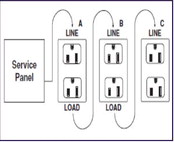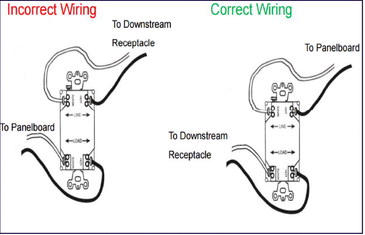Circuit protection devices include circuit breakers, fuses, and ground fault circuit interrupters. They are mostly used to protect people, but also the circuit and equipment from overloading, which can cause serious damage like shocks or fires.
Overloading happens when a conductor is unable to withstand the amount of current provided. When this happens, the wire overheats. Heat is produced as a result of friction caused when the electrons flow and encounter the wire’s atoms. That is why it is important to use the appropriate size and type of wire so that it can conduct electricity without overheating.
Sometimes a given circuit is asked to provide more amperage than it is designed for. Too many appliances may be running simultaneously. When this occurs, a fire could result as the wires in the circuit get too hot.
• Circuit breakers
To protect against this danger, circuit breakers and fuses are incorporated on the system to break the circuit when the current becomes greater than the wires can withstand.
A circuit breaker is a device that shuts off a circuit when there is excessive current flowing through the wires. They can be reset by hand and used again and again. They come in different sizes to protect against different amounts of current. For example, there are 15 amp breakers, 20 amp breakers, and so on. It’s important to use the appropriate type breaker for the circuit. A #14 wire can safely carry 15 amps and should therefore be protected with a 15 amp breaker. Using a 20 amp breaker on such a circuit would allow more current on the wire than is safe, and the wire could heat up and start a fire.
It’s a bad idea to reset a circuit breaker without determining the cause of the overload. It’s also important to know that circuit breakers can wear out and should not be used as an on/ off switch for equipment.
• Fuses
Fuses provide the same service as circuit breakers: to open the circuit when there is an overload. They perform this service a little differently, however.
Fuses have a piece of wire inside of them that melts easily at fairly low temperatures. Common fuses come rated for 15, 20, or 30 amperes to suit the gauge wire in the circuit. Unlike circuit breakers, they cannot be reset when they open the circuit, because they are destroyed by the process of breaking the circuit. The fuse must be replaced, and care taken to replace with a fuse of the same rating.
• GFCIs
In addition to the electrical hazard of fire from overloads or short circuits, there is also the possibility of shock or electrocution. Figure 3: Source: National Electrical Manufacturers Association. Graphic shows the number of electrocutions has gone down with the prevalence of GFCIs.
Like fuses and circuit breakers, GFCIs are also fast-acting circuit breakers designed to shut off electricity when it detects that current is flowing along an unintended path, such as water or a person.
The Ground Fault Circuit Interrupter is a case of necessity being the mother of invention. According to the National Electrical Manufacturers Association, in the mid 1970s, 600 people were electrocuted each year. By the turn of the century, that number had dropped to fewer than 200. Among the biggest reasons for that drop was the GFCI.
A ground fault circuit interrupter is a device that shuts off the power to an electrical circuit when it detects current is flowing along an unintended path. It is a safety device wired across a circuit to protect people from shock due to ground fault electric current. It works by measuring the current leaving the power source, or the hot wire, into the load, and comparing that current to the return side, or the neutral wire.
If the current is not equal, then there must be a leak somewhere, so the GFCI turns the power off. A GFCI turns off the power if the current on the neutral side is less than the current on the load side by a very small amount (from 4 to 6 milliamps) because in normal operation, the flow of electricity will be equal. A difference causes the GFCI to trip within 25 milliseconds and open the circuit.
Local laws require GFCIs to be installed in kitchens, bathrooms, unfinished basements, anywhere near a sink, and outdoors. In other words, they are required anywhere where water could allow a short circuit to occur.
The National Electrical Code requires GFCI protection for luminaries, lighting outlets, circulation, sanitation system equipment, and pump motor receptacles located near swimming pools. All receptacles rated 125 volts through 250 volts, 60 amps or less, located within 20 feet of the walls of a pool must be protected by GFCI devices.
It is essential to be familiar with the details of the NEC.
When a GFCI is tripped, the device must be reset manually by pressing the reset button. If the problem has not been fixed, the GFCI will continue to shut off.
For permanent installation, GFCIs are available in two types. Most consumers are familiar with the receptacle type GFCI, which is similar to a common wall outlet. A receptacle type is installed in an electrical outlet box. Also available is a circuit breaker type that is installed in an electrical panel. These provide protection for every receptacle on that individual circuit.
Then there are also GFCIs that are attached to appliance cords like hair dryers and electric tools. These are temporary GFCIs and should not be used as an alternative to a permanent GFCI.
GFCIs should be tested on a monthly basis to ensure that they are still functional. They are electronic devices that can become damaged or wear out. Even if the GFCI circuit no longer works, the electrical receptacle may still continue to function, and this can present a dangerous situation. With either the circuit breaker GFCI or the receptacle GFCI, pushing the test button should turn off the power to the circuit.
With receptacle GFCIs, pressing the test button should cause the reset button to pop up. With circuit breaker GFCIs, pressing the test button should cause the handle to move to the tripped position. In either case, remember to press the reset button or Circuit
From page 14
reset the handle to re-establish power and protection.
Many locations require GFCI protection, so it’s important to know how to install these devices. Installers need to understand how GFCIs function in order to provide their customers with the best installation.
But before attempting any electrical work, turn off the power at the service panel, and lock the electrical power box to prevent an unauthorized person from turning the power on.
GFCI receptacles have input holes or screws and output holes or screws referred to as the “line” leads and “load” leads. The line terminals are for connections from the service panel. The load terminals are to deliver power to another receptacle in the circuit. If there are no other receptacles on the circuit, the load lead should not be used.
The electrical cable coming from the service panel consists of two or three wires. It has a black hot wire, a white neutral wire, and a green grounding wire. From the service panel, the black hot wire is connected to a black or brass hot line terminal. The white wire is connected to the white or silver line terminal. The green wire is connected to the green grounding terminal.
One aspect of GFCI protection to Figure 4: The Back of a GFCI consider is placement.
That is because the GFCI’s location along the circuit determines whether or not it also protects other receptacles along the circuit. (See accompanying figure on GFCI placement.) If the GFCI is placed in position A, it will also provide protection to the load side, or receptacles B and C. If instead, the GFCI is in position C, it will not provide protection to receptacles A and B.
When replacing an old receptacle, the situation can get slightly more complicated. For example, the existing receptacle may also be connected to another receptacle, and it’s important to identify its position in the series.
Remove the old receptacle from the electrical box. If there is only one cable consisting of 2 to 3 wires, the receptacle is probably in position C or else it is the sole receptacle for the circuit. (See the graphic for GFCI placement.)
On the other hand, when the old receptacle has been removed and there are two cables for a total of 4 to 6 wires, the receptacle is in position A or B. Don’t assume that the old receptacle was correctly wired. Detach one of the cable’s white wire and hot wire from the receptacle and cap each one separately with a wire connector. Be sure that the wires are from the same cable. Connect the other cable to the receptacles line leads.
Reinstall the receptacle in the electrical box, attach the faceplate, and turn the power on. Determine if power is flowing to the receptacle. If power is flowing, then the capped wires are the load leads. If power is not flowing to the receptacle, the capped wires are the line leads.
One common installation mistake that workers and even electricians make is what is called line load reversal. Current standards for GFCI devices make it so that if the line and load cables are accidently reversed, the device simply will not work. In older devises, however, it was possible to reverse the line and load connections. In the case of some of the older GFCIs where the line and load cables are reversed, the outlet will continue to provide electricity, even when the test button has been pressed.
Generally, people test their GFCIs by pressing the test button. This makes the reset button pop out, a signal that the outlet is now dead, and the GFCI has done its job. But with GFCIs where the line and load are reversed, that indicative pop still occurs, but the outlet is still live: a false positive. Furthermore, all outlets that are connected downstream of this outlet, presumed to be GFCI protected from the upstream GFCI, are also still live.
Figure 5: GFCI Placement Circuit
From page 15
It is extremely common to find this mistake, and there are GFCI threelight testers that are available at most hardware stores that can diagnose this and other potentially dangerous situations.
Another installation mistake is called reversed polarity, where the hot wire is connected to the neutral terminal, while the neutral wire is connected to the hot terminal. Appliances plugged into outlets whose polarity was reversed will still work, but they are dangerous. That’s because most appliances are wired to have the hot side of the circuit, not the neutral, controlled by their on/ off switches.
They present a shock hazard because even when they are off, if they are still plugged into an outlet whose hot and neutral wires were reversed, they are still getting electricity.
People touching the outside metal of light bulbs and many other appliances have been known to get shocked.
Figure 6: Line/Load Reversal


